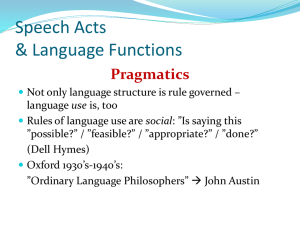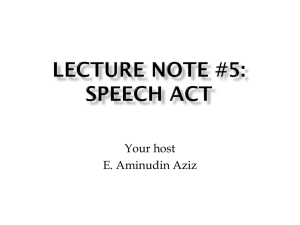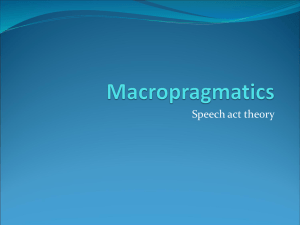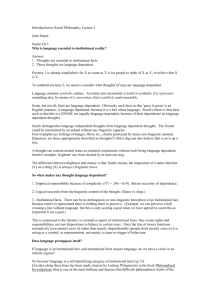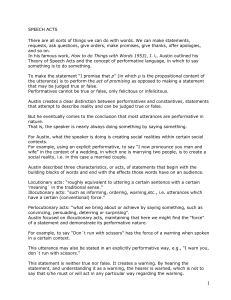SPEECH ACT THEORY – THE FOUNDING FATHERS
advertisement
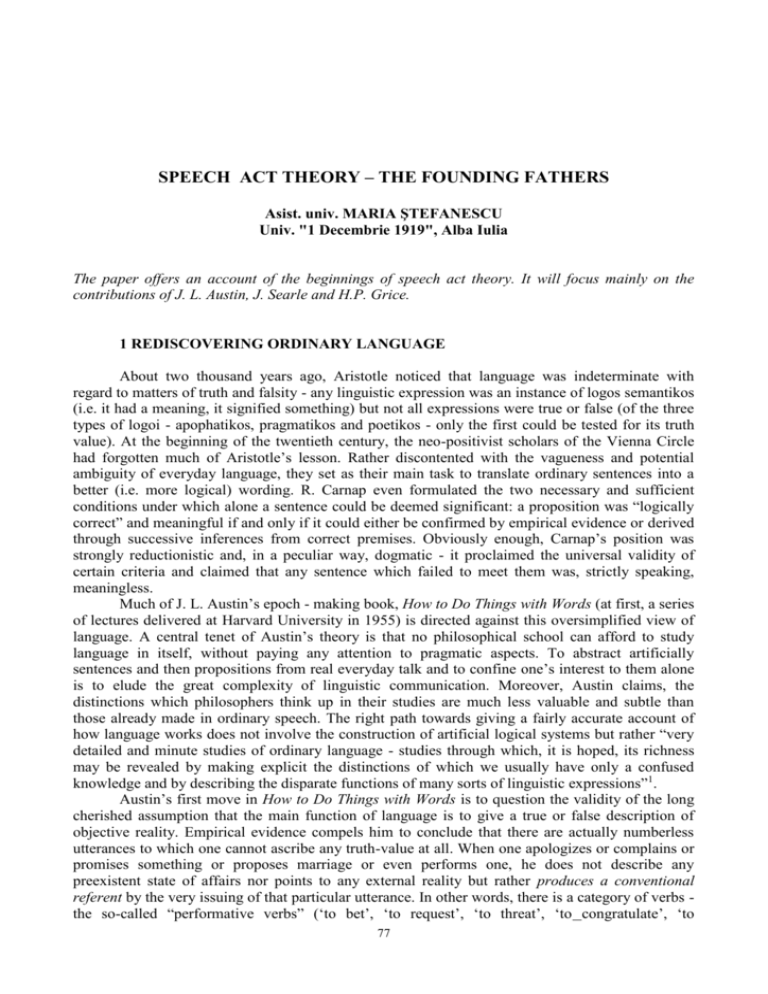
SPEECH ACT THEORY – THE FOUNDING FATHERS Asist. univ. MARIA ŞTEFANESCU Univ. "1 Decembrie 1919", Alba Iulia The paper offers an account of the beginnings of speech act theory. It will focus mainly on the contributions of J. L. Austin, J. Searle and H.P. Grice. 1 REDISCOVERING ORDINARY LANGUAGE About two thousand years ago, Aristotle noticed that language was indeterminate with regard to matters of truth and falsity - any linguistic expression was an instance of logos semantikos (i.e. it had a meaning, it signified something) but not all expressions were true or false (of the three types of logoi - apophatikos, pragmatikos and poetikos - only the first could be tested for its truth value). At the beginning of the twentieth century, the neo-positivist scholars of the Vienna Circle had forgotten much of Aristotle’s lesson. Rather discontented with the vagueness and potential ambiguity of everyday language, they set as their main task to translate ordinary sentences into a better (i.e. more logical) wording. R. Carnap even formulated the two necessary and sufficient conditions under which alone a sentence could be deemed significant: a proposition was “logically correct” and meaningful if and only if it could either be confirmed by empirical evidence or derived through successive inferences from correct premises. Obviously enough, Carnap’s position was strongly reductionistic and, in a peculiar way, dogmatic - it proclaimed the universal validity of certain criteria and claimed that any sentence which failed to meet them was, strictly speaking, meaningless. Much of J. L. Austin’s epoch - making book, How to Do Things with Words (at first, a series of lectures delivered at Harvard University in 1955) is directed against this oversimplified view of language. A central tenet of Austin’s theory is that no philosophical school can afford to study language in itself, without paying any attention to pragmatic aspects. To abstract artificially sentences and then propositions from real everyday talk and to confine one’s interest to them alone is to elude the great complexity of linguistic communication. Moreover, Austin claims, the distinctions which philosophers think up in their studies are much less valuable and subtle than those already made in ordinary speech. The right path towards giving a fairly accurate account of how language works does not involve the construction of artificial logical systems but rather “very detailed and minute studies of ordinary language - studies through which, it is hoped, its richness may be revealed by making explicit the distinctions of which we usually have only a confused knowledge and by describing the disparate functions of many sorts of linguistic expressions”1. Austin’s first move in How to Do Things with Words is to question the validity of the long cherished assumption that the main function of language is to give a true or false description of objective reality. Empirical evidence compels him to conclude that there are actually numberless utterances to which one cannot ascribe any truth-value at all. When one apologizes or complains or promises something or proposes marriage or even performs one, he does not describe any preexistent state of affairs nor points to any external reality but rather produces a conventional referent by the very issuing of that particular utterance. In other words, there is a category of verbs the so-called “performative verbs” (‘to bet’, ‘to request’, ‘to threat’, ‘to congratulate’, ‘to 77 welcome’, ‘to declare war’, ‘to baptize’ a.s.o.) - which, when deployed with their performative function, actually do things. One’s promise, Austin says, will never be true or false but it can turn out to be felicitous or infelicitous. The success or failure of such utterances is a matter of collective accord and depends on the agreements observed by various sociolinguistic communities. One could not overemphasize the importance within the speech act theory of the notion of social convention (in fact, Austin even considered adopting the word ‘contractual’ instead of inventing the word ‘performative’). The ‘referent’ of “I now pronounce you husband and wife” is the conventional effect of a conventional procedure and the marriage will only be a fact if the ceremony is made under the previously specified appropriate circumstances. In How to Do Things with Words, Austin provides a list of what he calls the “felicity conditions” for any performative utterance: “(A.1) There must exist an accepted conventional procedure having a certain conventional effect, that procedure to include the uttering of certain words by certain persons in certain circumstances, and further, (A.2) the particular persons and circumstances in a given case must be appropriate for the invocation of the particular procedure invoked. (B.1) The procedure itself must be executed by all participants both correctly and (B.2) completely. (.1) Where, as often, the procedure is designed for use by persons having certain thoughts or feelings for the inauguration of certain consequential conduct on the part of any participant, then a person participating in and so invoking the procedure must in fact have those thoughts or feelings, and the participants must intend so to conduct themselves and further, (.2) must actually so conduct themselves subsequently”2. Austin’s distinction, with regard to the various types of infelicity, between the four rules A and B taken together and the two rules , comes down to the difference between “misfires” (the cases when the intended action fails to come off owing to inappropriate circumstances) and “abuses” (when the act is executed but infelicitously - for instance, a promise made in bad faith). A brief account is necessary of the steps through which “what starts off as a theory about some special and particular utterances ends up as a general theory of language “3. Austin’s technique of constantly questioning each seemingly firm conclusion makes him give up the idea that performatives are accidental aspects of speech in favour of the view that there is a large class of performative utterances which includes both explicit and implicit performatives; later on, the dichotomy constative - performative itself will be dislocated and replaced with an overall theory of illocutionary acts: “The doctrine of the performative/constative distinction stands on the doctrine of locutionary and: illocutionary acts in the total speech act as the special theory to the general theory. And the need for the general theory arises simply because the traditional ‘statement’ is an abstraction, an ideal, and so is its traditional truth/falsity”4. Since statements are liable to every kind of infelicity to which performatives are liable (i.e. they can go wrong in various ways because of disabilities which make them unhappy without, however, making them true or false), one is bound to admit that, ultimately, stating is performing an act. The conclusion is given in the shape of a summary: “We first distinguished a group of things we do in saying something, which together we summed up by saying we perform a locutionary act, which is roughly equivalent to uttering a certain sentence with a certain sense and reference, which again is roughly equivalent to ‘meaning’ in the traditional sense. Secondly we said that we also perform illocutionary acts such as informing, ordering, warning, undertaking etc. , i.e. utterances which have a certain (conventional) force. Thirdly, we may also perform perlocutionary acts: what we bring about or achieve by saying something, such as convincing, persuading, deterring and even, say, surprising or misleading”5. It is important to notice here Austin’s strong emphasis on the conventional nature of illocutionary force (the issue was to become a stumbling block for later speech act theories - see, for 78 instance, Strawson’s criticism of Searle’s “amendments” to Grice’s theory of meaning). Whereas the perlocutionary effects are subjective and virtually unpredictable, the illocutionary force is determinate, in principle at least, because it has its roots in a conventional system of social interaction. The speech performance examined with reference to the context of interlocution - “the total speech act in the total speech situation” - is said to be “the only actual phenomenon which, in the last resort, we are engaged in elucidating “6. Austin’s profession of faith, pragmatist avant la lettre, is rendered more explicit when he distinguishes between illocutionary effects and perlocutionary results and focuses his attention on the former. The successfulness of a speech act hinges in part on securing uptake (the understanding of the meaning and of the force of the locution), taking effect and inviting a response; in other words, the triad speaker - utterance - hearer, placed within a social context, is only brought to life by the interplay of communicative intentions and effects. 2 SEARLE, THE CRUSADER It is beyond doubt that the second great contribution to the development of speech act theory belongs to the American philosopher J. R. Searle. One could argue, nevertheless, that the two important books he publishes on the topic are also, in a way, a little of a hindrance to the progress of the theory. With strong determination, Searle sets to putting thing in order in the allegedly untamed field of speech act studies: he dismisses Austin’s characterizations in terms of loose “family relationships” and provides instead stern rules and rigidified necessary and sufficient conditions. His own account of his method will do as a good introduction: “The hypothesis then of this work [Speech Acts. An Essay in the Philosophy of Language] is that speaking a language is engaging in a rule - governed form of behaviour. To put it more briskly, talking is performing acts according to rules. In order to substantiate that hypothesis and explicate speech, I shall state some of the rules according to which we talk. The procedure which I shall follow is to state a set of necessary and sufficient conditions for the performance of particular kinds of speech acts and then extract from those conditions sets of semantic rules for the use of the linguistic devices which mark the utterances as speech acts of those kinds”1. The big problem for Searle is how to link illocutionary force with such illocutionary force indicating devices (IFIDS) as performative verbs, word order, stress, intonation contour, punctuation, the mood of the verbs etc. In order to find a solution, he draws on Rawls’ distinction between regulative rules and constitutive rules: the former control antecedently/independently existing activities (eg. traffic regulations) whereas the latter create the activities themselves. Thus, Searle notices, in the case of a football game, if there were no rules of football there would be no sense at all in which the player’s behaviour could be described as playing football. Similar constitutive rules underlie the performance of each speech act and provide the necessary link between IFIDS and their corresponding illocutionary acts. This conclusion encourages Searle to postulate the existence of a set of adequacy conditions, different from those specified by Austin, the most important of which is called “the essential condition” and is said to work on the pattern “uttering IFID X counts as doing Y”. The other three prerequisites are the preparatory condition, the propositional content condition (it concerns real-world constraints on the meaning of utterances) and the condition on sincerity. Searle’s devising his own adequacy conditions does not separate him from Austin (despite S. Petrey’s opinion that the American philosopher privileges the present definition of the act performed - X counts as Y - over the prior social reality necessary for speech to act, in fact Searle does take into account the conventional nature of all constitutive rules2) but the sincerity condition is certainly a point on which the two philosophers are hardly at one. Unlike Austin, for whom subjective intentions do not matter and who is careful to specify that a promise remains a promise even if it is given in bad faith, Searle decides to direct attention to individual 79 performance rather than collective production and to rank sincerity of intention among the sine qua non conditions for successful speech acts. Under the Searlean revision, Austin’s theory undergoes further significant changes: although the central notions of illocution and perlocution are preserved with their initial meaning, the old locutionary act is split in two so that uttering words (morphemes, sentences etc.) is said to count as performing utterance acts, while referring and predicating will be equivalent to producing propositional acts. For many readers of Speech Acts, Searle’s strong emphasis on the propositional acts (the chapters about meaning and predication cover almost half of the volume) might look like a roundabout way of resurrecting the language - as - description theory. After all, the very first sentence of the book is “How do words relate to the world ?”. But, although he states that “to know the meaning of a general term and hence a predicative expression is to know under what conditions it is true/false of a given objects” (emphasis added) and that “If a speaker asserts a proposition concerning an object he commits himself to there being the state of affairs in the world in which the predicate is true of the object (and mutatis mutandis for other kinds of speech acts). The predication indicates which state of affairs concerning the objects the speaker is committing himself to’’3, Searle is eager to specify that he keeps in mind a safe distinction between brute facts and institutional facts and is fully aware, unlike the supporters of extensionalism, that propositional acts can never occur, alone i.e. one cannot just refer or predicate without performing at the same time some other illocutionary act. After he postulates the existence of a principle of expressibility (whatever can be meant can be said), Searle discusses some of its “wide consequences” among which two are of considerable importance: 1) “the cases where the speaker does not say exactly what he means - the principal kinds of cases of which are nonliteralness, vagueness, ambiguity and incompleteness - are not theoretically essential to linguistic communication”. 2) “[the principle of expressibility] enables us to equate rules for performing speech acts with rules for uttering certain linguistic elements, since for any possible speech act there is a possible linguistic element the meaning of which (given the context of utterance) is sufficient to determine that its literal utterance is a performance of precisely that speech act. To study the speech acts of promising/apologizing we need only study sentences whose literal and correct utterance would constitute making a promise or issuing an apology”4. Both of Searle’s points can be subjected to criticism. Just like Austin, who found it more convenient not to tackle the problems raised by literary texts, Searle tries to play down the importance of those cases, rather thorny for his theory, when the speaker’s intent and the sentence meaning are at variance. But unlike Austin, who studies speech in order to find out the felicity conditions, Searle begins with the rules and establishes what is and what is not correct in language. The second consequence of the principle of expressibility, reiterated under the form “whenever the illocutionary force of an utterance is not explicit it can always be made explicit” 5), commits him to the so - called “literal force hypothesis” (according to Levinson6, this amounts to maintaining that explicit performatives have the literal force named by the verb in the main clause and that the three major sentence - types in English have the forces traditionally associated with them - stating, questioning and ordering). Any utterance the illocutionary force of which cannot be identified with the aid of either of the two above mentioned rules, i.e. any indirect speech act, will be treated as an uncomfortable exception. It might be that Ruth Kempson’s criticism of speech act theory in connection with this aspect is somehow misplaced. She notices that utterances which do not have a specific illocutionary force indicator can be used in a variety of ways and concludes from here that “a speech act semantics - if it is intended as a semantic characterization of the sentences of a language - is committed to predicting that all sentences of the language are multiply ambiguous” (emphasis added;7). The embedded conditional clause is very important here and the dubitative ‘if’ 80 is perfectly justified because, indeed, what speech act theorists are interested in is ‘only’ the meaning of utterances or, more precisely, that illocutionary force, different in each case, which is added to sentence meaning. But this answer to Kempson’s semantically-grounded criticism still does not address the main question which remains how to explain why people so often prefer to use roundabout and contorted phrases instead of straight and unambiguous expressions and, ultimately, why indirect speech acts exist at all. To this questions, Searle’s partial answer (partial because there are cases which his theory cannot account for in any satisfactory way and because he only tells how things happen not why) is to combine Grice’s theory of conversational co-operation with his own version of speech act theory and to claim that in the case of indirect speech acts the literal force, though recognized as such, is deemed conversationally unacceptable by the hearer and is substituted with some other “indirect force”, inferred with the aid of contextual clues. 3. MEANING BEYOND MEANING Although H. P. Grice’s relationship to speech act theory as developed by Austin and Searle is in no way one of mild submission, the two approaches to language are based pretty much on the same set of premises - the pragmatist assumption that concrete instances of speech and not language in the abstract should be of paramount interest and the conviction that sentence meaning alone cannot give a satisfactory account of how human communication works - and share the same method, namely an inquiry into the general presuppositions which, in one way or another, underlie any speech act. Grice’s conversationalist doctrine is announced by an article from 1957, Meaning, where he distinguishes between the conventional content of an utterance (that part of meaning which arrests the interest of most semantic theories) and what he calls “non - natural meaning”, the supplementary sense which the speaker may wish to add to what he explicitly says. In Grice’s own characterization, “S meant - nn z by uttering U if and only if: (I) S intended U to cause some effect z in recipient H (ii) S intended (I) to be achieved simply by H recognizing that intention”1; here S stands for speaker, H for hearer, U for utterance (of a sentence part, sentence, string of sentences) and Z for some belief or volition invoked in H. In other words, the process of communication is ultimately a process of recognition of intentions (the sender’s conveyed meaning becomes mutual knowledge to sender and receiver). One objection to this account could be that Grice tends to overemphasize the importance of getting a correct insight into the speaker’s mind; in fact, a speech act should rather be conceived of as a dialogue in which the meaning does not belong to the speaker alone but to the interaction between the speaker and the hearer. Logic and Conversation, another very important article of Grice’s draws on the already discussed idea that one can distinguish, within the total signification of an utterance between what is actually expressed and what is merely suggested. The additional context-specific meaning is said to be the result of successive pragmatic inferences on the part of the hearer. The new concept of implicature (which, in its author’s intention, should be contrasted with logical implication and entailment) seems to be a general cover term which includes both conventional implicatures (i.e. non truth - conditional inferences that are not derived from superordinate pragmatic principles) and conversational implicatures. The latter will be identified on the basis on what Grice calls “maxims of conversation”, a set of principles which underlie the communicationally efficient use of language (in fact, they retain aspects of both Austin’s felicity conditions and Searle’s rules and axioms). This communicative efficiency is provided first of all by the co - operative principle which all participants to speech are expected to observe: “Make your conversational contribution such as is required, at the stage at which it occurs by the accepted purpose or direction of the talk exchange in which you are engaged”3. Beside this basic principle there are four other categories which, echoing 81 Kant, Grice calls quantity, quality, relation and manner, each having its own specific maxims and submaxims: “The category of Quantity relates to the quantity of information to be provided, and under it follow the maxims: 1. Make your contribution as informative as is required (for the current purpose of the exchange). 2. Do not make your contribution more informative than is required [...] Under the category of Quality falls a supermaxim - “Try to make your contribution one that is true” - and two more specific maxims: 1. Do not say what you believe to be false. 2. Do not say that for which you lack adequate evidence. Under the category of Relation I place a single maxim, namely “Be relevant”. [...] Finally, under the category of Manner [...] I include the supermaxim - “Be perspicuous” - and various maxims such as: 1. Avoid obscurity of expression. 2. Avoid ambiguity. 3. Be brief (avoid unnecessary prolixity). 4. Be orderly. And one might need other”4. At this point, Grice’s method comes surprisingly close to Austin’s: after having identified the maxims, he specifies the possible ways in which a participant to a talk exchange may fail to fulfill them. It is worth mentioning here the case when a speaker floats the maxims, i.e. deliberately and blatantly fails to meet the requirements. The situation is important because it is the one which characteristically distinguishes literary texts (particularly poetry) from any other types of discourse and has to be given special treatment. Grice’s ingenious solution is to claim that in such cases one has to do with an “exploitation” of the maxims: the poet who creates a metaphor knows that his readers are aware of his commitment to the co - operative principle and that he can afford to overlook the ordinary conditions of intelligibility in order to create a completely different meaning. In fact, Grice’s idea that one can exploit the maxims is bound to have a significant impact on any pragmatic theory of language because “there is a fundamental way in which a full account of the communicative power of language can never be reduced to a set of conventions for the use of language. The reason is that whenever some convention or expectation about the use of language arises, there will also therewith arise the possibility of the non-conventional exploitation of that convention or expectation. It follows that a purely conventional or rule-based account of natural language usage can never be complete, and that what can be communicated always exceeds the communicative power provided by the conventions of the language and its use”5. But this more complex issue – how the second generation of speech act theorists have tried to deal with the problems caused by overemphasizing the importance of linguistic convention – will not be addressed here. 82 NOTES 1. REDISCOVERING ORDINARY LANGUAGE 1. J. O. Urmson, apud The Linguistic Turn. Recent Essays in Philosophical Method, edited and with an introduction by R. Rorty, the University of Chicago Press, Chicago and London, 1967, p. 247 2. J. L. Austin, How to Do Things with Words, Harvard University Press, Cambridge, Massachusetts, 1975, pp 14 - 15 3. Stephen C. Levinson, Pragmatics, Cambridge University Press, Cambridge, 1993, p. 231 4. J. L. Austin, op. cit. , p. 148 5. ibis. , p. 109 6. ibis. , p. 148 2. SEARLE, THE CRUSADER 1. John R. Searle, Speech Acts. An Essay in the Philosophy of Language, Cambridge University Press, Cambridge, 1977, p. 22 2. ibid. , p. 38 3. ibid. , p. 125 4. ibid. , p. 21 5. ibid. , p. 68 6. S. C. Levinson, op. cit. , p. 264 7. Ruth M. Kempson, Semantic Theory, Cambridge University Press, Cambridge, 1989, p. 59 3. MEANING BEYOND MEANING 1. apud Levinson, op. cit. , p. 16 2. ibid., p. 127 3. H. P. Grice, Logic and Conversation in Pragmatics. A. Reader, ed. Steven Davis, Oxford University Press, Oxford, 1991, p. 307 4. ibid. , p. 308 5. S. C. Levinson, op. cit. , p. 112 BIBLIOGRAPHY 1. Austin, J.L. ,How to Do Things with Words, Harvard University Press, Cambridge, Massachusetts, 1975, 2 nd edition 2. Grice, H. Paul ,”Utterer’s Meaning, Sentence - Meaning, and Word - Meaning” in Pragmatics. A Reader, Ed. Steven Davis, Oxford University Press, New York, Oxford, 1991 3. Grice H. P. ,“Logic and Conversation”, in Pragmatics. A Reader ... 4. Kempson, M. Ruth ,Semantic Theory, Cambridge University Press, Cambridge, 1989 5. Levinson, Stephen C. ,Pragmatics, Cambridge University Press, Cambridge, 1993 6. Searle, John R. ,Speeach Acts. An Essay in the Philosophy of Language, Cambridge University Press, Cambridge, 1977 7. Urmson, J. O. ,”J. L. Austin” in The Linquistic Turn. Recent Essays in Philosophical Method, edited and with an introduction by R. Rorty, the University of Chicago Press, Chicago and London, 1967 83
